Fish in a parcel, Mediterranean style
Friday, August 4, 2017
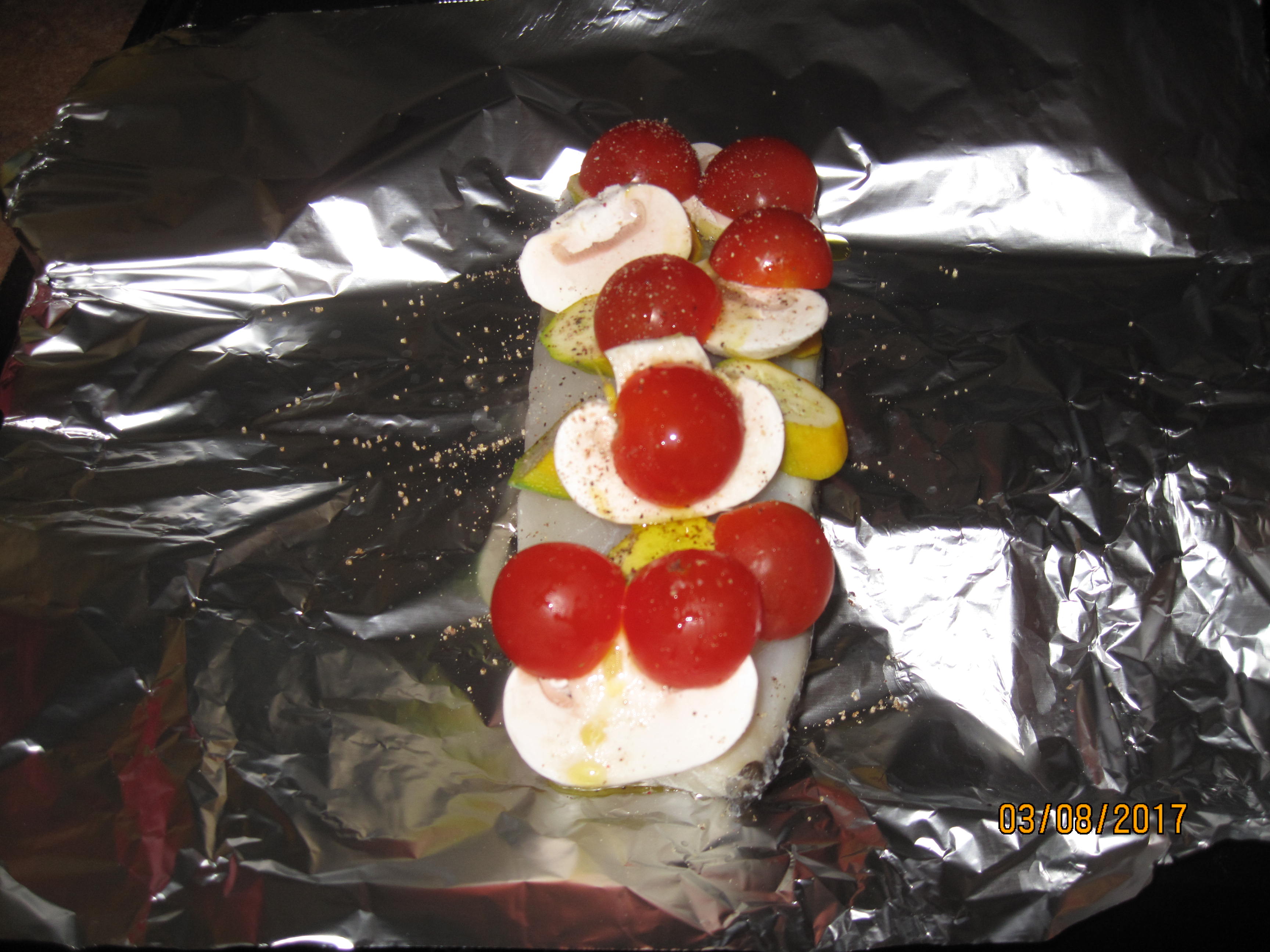 At the moment we're in England, and I'm missing the Mediterranean - especially the weather. There's not a lot I can do about that, but I can bring a touch of the Mediterranean to the table. Just before we left Spain, one of our favourite bodegas and frozen food outlets closed down, and they sold all the stock off at half price. Among the €200 of bargain booze and food I snagged were some frozen cod loins, and I brought some of those over with us, as fish tends to be rather expensive over here. At the moment we're in England, and I'm missing the Mediterranean - especially the weather. There's not a lot I can do about that, but I can bring a touch of the Mediterranean to the table. Just before we left Spain, one of our favourite bodegas and frozen food outlets closed down, and they sold all the stock off at half price. Among the €200 of bargain booze and food I snagged were some frozen cod loins, and I brought some of those over with us, as fish tends to be rather expensive over here.
Tony likes his fish as Nature intended, or with batter, but I'm a great fan of Mediterranean-style baked fish with vegetables. Instead of doing it in a dish, I made two foil parcels - one au naturel for Tony with lemon juice, salt and pepper, and another for me.
I seasoned the fish with lemon juice, salt and pepper, then I halved some cherry tomatoes and sliced up a baby courgette an English friend had grown in her garden. Finally I sliced up a couple of button mushrooms and piled the mixture on top of the cod. I added a dash of olive oil for extra flavour, then sealed the parcel and baked it in a hot oven for 20 minutes. While the fish was cooking, I prepared chips from Maris Piper potatoes for Tony, and a jacket potato for myself.
As an aside, that's one thing we miss in Spain - named variety potatoes. Although the market stall holders insist that all their potatoes are 'para frier' - for frying - and Consum even label their spuds as such, we don't have a lot of success with chips from Spanish potatoes. It's not uncommon to get three different coloured chips from the same bag of spuds, varying in appearance from soggy and dark through firm and pale to golden and almost crispy but not quite. So we make the most of the named varieties while we're here, and take a sack of Wiljas back with us in September so we - or rather Tony - can enjoy decent chips for a few more weeks.
Anyway, the fish turned out fabulously - firm, white and cooked through, with the vegetables still slightly al 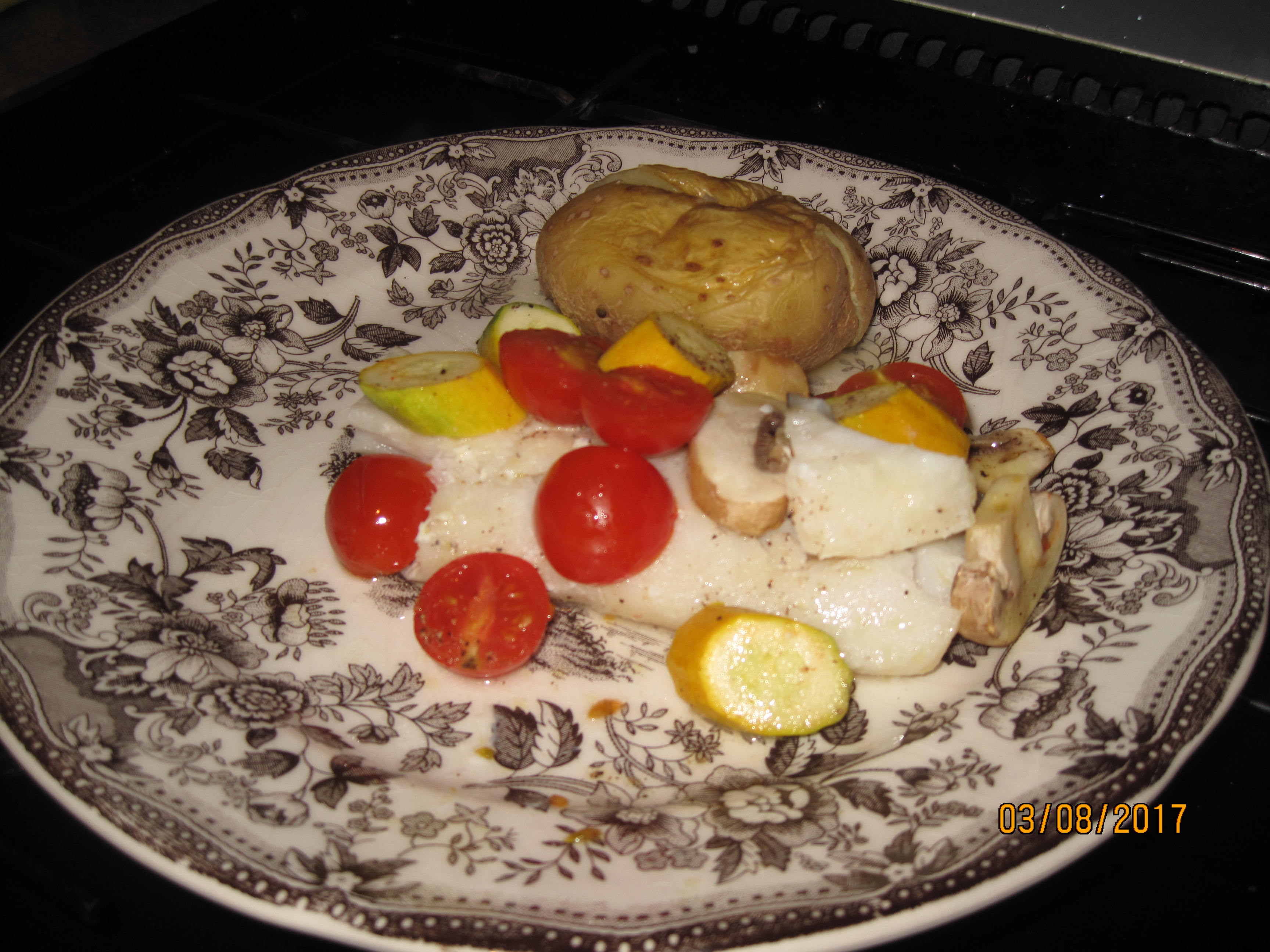 dente but also nice and juicy - which is just how I like them. And the best part was, I didn't have a cazuela to wash out, which is a bonus when you're in a static caravan sans dishwasher. I just threw the foil away. Foil parcels are a great way to cook all sorts of fish, either alone or with vegetables, although the extra moisture from the vegetables stops the fish drying out if you leave it for too long in the oven or on the barbecue. dente but also nice and juicy - which is just how I like them. And the best part was, I didn't have a cazuela to wash out, which is a bonus when you're in a static caravan sans dishwasher. I just threw the foil away. Foil parcels are a great way to cook all sorts of fish, either alone or with vegetables, although the extra moisture from the vegetables stops the fish drying out if you leave it for too long in the oven or on the barbecue.
If you haven't cooked fish like this before, why not give it a go? You won't be disappointed, and it's much healthier than frying. So easy to cook and serve too - what's not to love? Buen provecho, amigos!
For much more about Spain, visit Sandra in Spain.com
 0
Like
Published at 3:56 PM Comments (8)
0
Like
Published at 3:56 PM Comments (8)
Fresh lemon curd - straight from the tree!
Wednesday, April 5, 2017
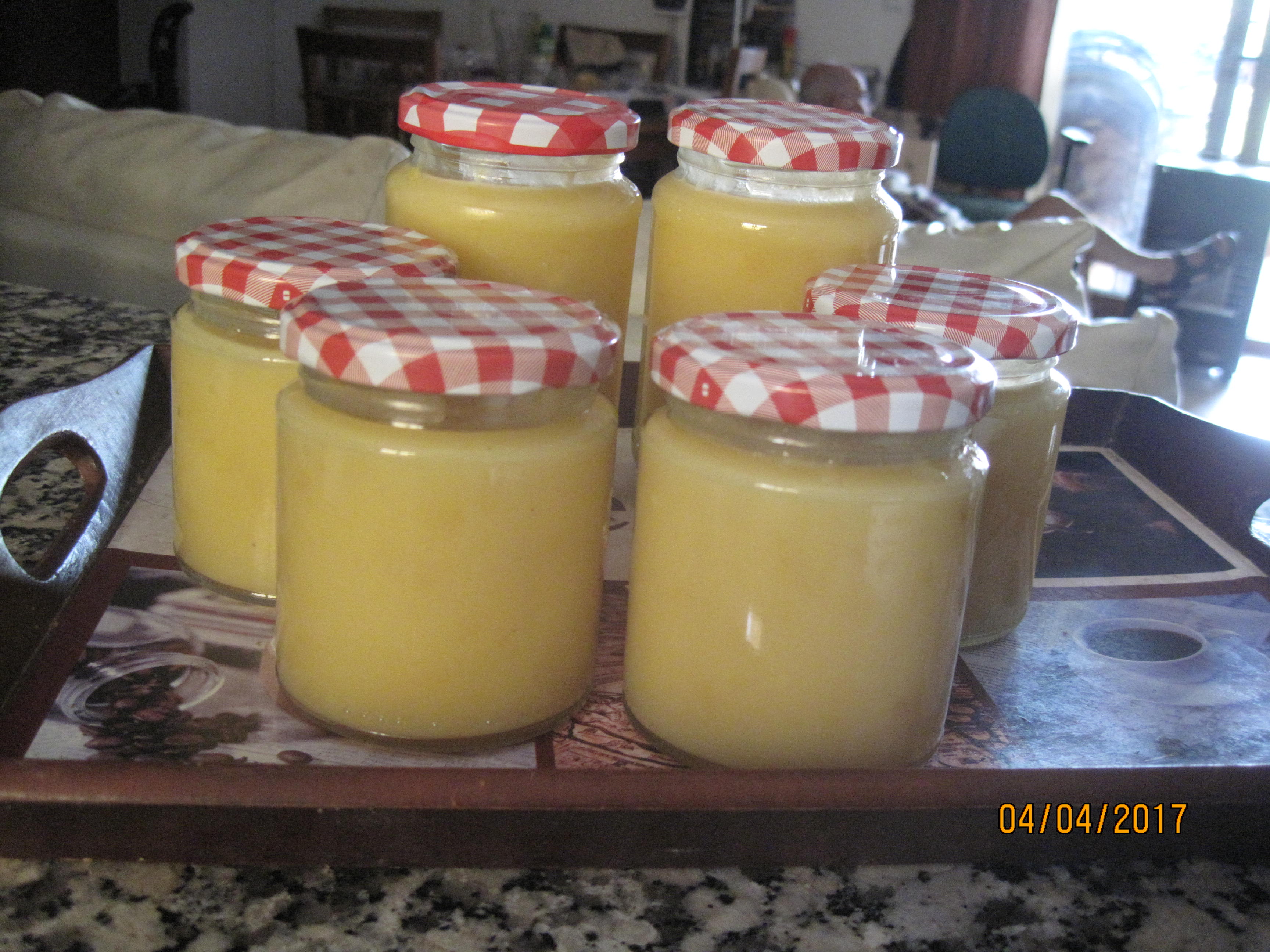 After last year’s bumper crop of about 50 lemons on our tree in the garden, I expected a lean time of it this year. However, the tree has obviously got its mojo working now, because there are even more of them this year, and they’re bigger and even better. Some of them could even go to a fancy dress party as grapefruits or even small melons with very little adaptation. I’ve already made preserved lemons fresh lemonade and lemon marmalade, as well as using a few in gins and tonics and vodka and lemonade, just to stop them going soft. Today’s make is home-made lemon curd. After last year’s bumper crop of about 50 lemons on our tree in the garden, I expected a lean time of it this year. However, the tree has obviously got its mojo working now, because there are even more of them this year, and they’re bigger and even better. Some of them could even go to a fancy dress party as grapefruits or even small melons with very little adaptation. I’ve already made preserved lemons fresh lemonade and lemon marmalade, as well as using a few in gins and tonics and vodka and lemonade, just to stop them going soft. Today’s make is home-made lemon curd.
As I child, I loved lemon curd in tarts, sponges and on toast, and I haven’t lost the taste for it, although my palate’s become a little jaded after years of shop bought stuff. In England, with the price of lemons, eggs and butter, it’s an expensive make, but here in Spain, I made a goodly quantity for around €2.50, plus a bit of elbow grease and electric.
It’s surprisingly easy, if a little time consuming, but it’s worth it. The recipe is one I adapted from the BBC Food site. I doubled up on quantities, as it only made 2 - 3 jars, and I had friends lining up as tasters! This will make around 5 x 350g jars or 7 x 250g. Don’t be tempted to use larger jars, because once it’s open, it soon begins to deteriorate, even when kept in the fridge.
I always sterilise the jars in the oven, then fill them while the lemon curd is still warm but not too hot. Heat the oven to 160C/325F/ Gas mark 3 and place the jars on a tray in the oven for between 15 and 30 minutes.
You can make lemon curd in a large saucepan, or use a large bowl as a bain-marie. I prefer the latter, because there’s no risk of burning the mixture, there are no messy saucepans to clean, and you don’t leave any on the sides of the pan. If you don’t have a big bowl, do as I did and use the inner lining of a 3.5 litre crock pot or slow cooker standing in a large saucepan of water. Whether you’re using your own lemons or buying them from the market, pick or purchase them at the last minute – the fresher they are, the better your lemon curd will taste. Here’s the recipe:
- 8 – 10 lemons, depending on size. As mine were so big, I only used 7. Remove the zest and squeeze out the juice. If you don’t have a zester, use a fine grater or vegetable peeler to remove the peel before juicing the lemons. If the pieces of peel are too large, chop them with a vegetable shopper or a sharp knife. An electric juicer will extract more juice, and the lemons should be at ambient temperature, so don’t store them in the fridge.
- 400g/ 14oz of caster sugar.
- 200g/ 7oz butter cut into cubes. The recipe suggests unsalted butter, but I think regular salted butter gives a better flavour.
- 6 large eggs + 2 extra egg yolks. Lidl or Mercadona are cheapest for large eggs.
Combine all the ingredients except the eggs in a large bowl, and set it over a pan of simmering water. Stir the mixture until the butter is melted, then whisk the eggs and fold them into the other ingredients. Allow the lemon curd to cook for approximately 15 – 20 minutes, stirring now and then. It’s ready as soon as the mixture is really thick and creamy and coats the back of a wooden spoon. Let it cool a little, then divide it between your jars.
It really is that easy! You can eat it as soon as it’s cool, but it will be even better if you can exercise a little patience and allow the flavours to develop for a few weeks. A word of warning though - once you’ve tasted fresh home-made lemon curd, you’ll never want to go back to the shop bought stuff!
There are more recipes and interesting reads at Sandra in Spain.com
 1
Like
Published at 2:18 PM Comments (3)
1
Like
Published at 2:18 PM Comments (3)
Aubergines with tomato and cheese
Wednesday, July 20, 2016
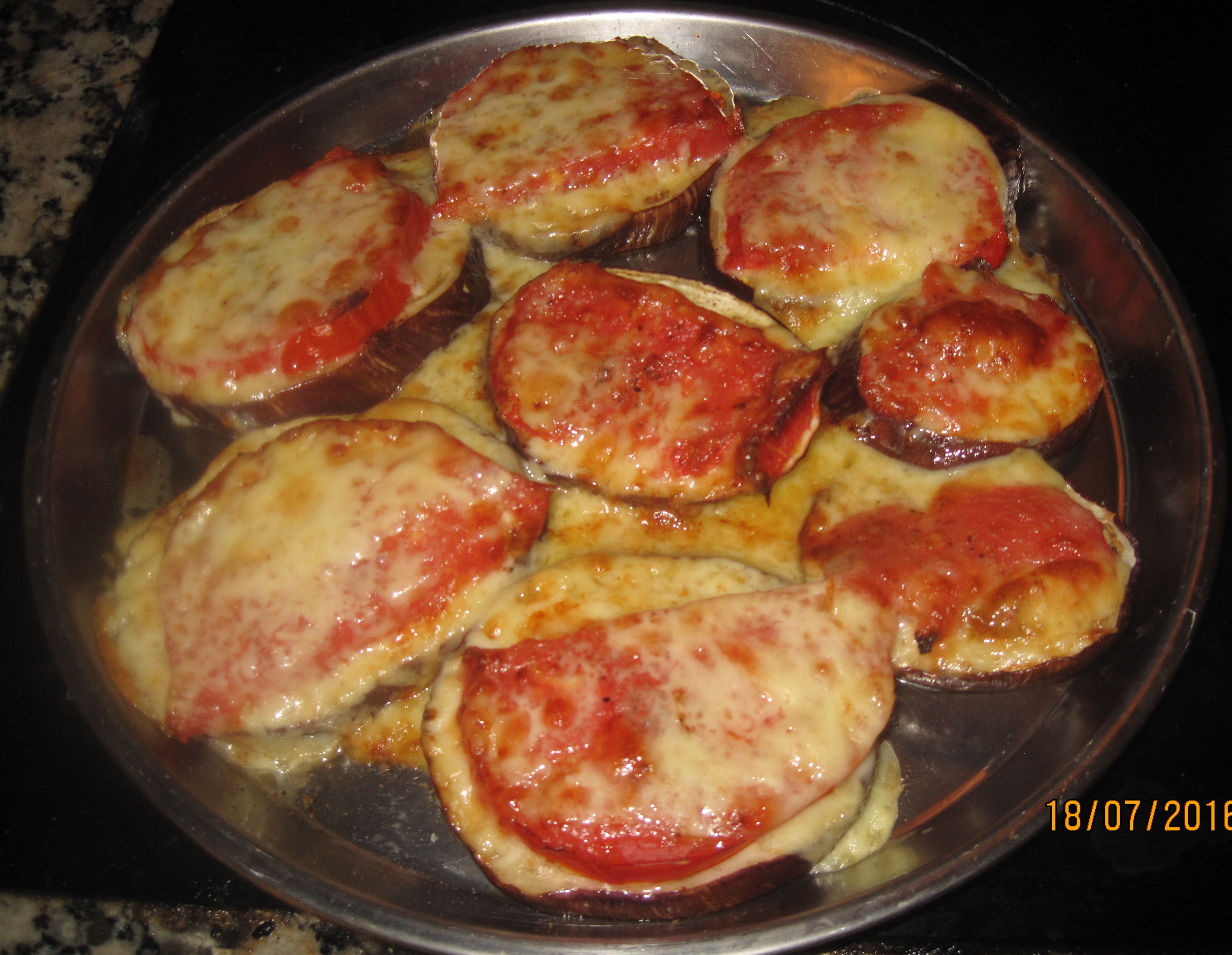 One of the best things about living in Spain is the availability and affordability of lovely fresh fruit and vegetables. A trip down the market will yield a trolley full of fresh, in season fruit and veg for around €10 or less. And it's as good as organic, because the small producers who sell their produce on the markets don't use chemical fertilisers and pesticides. What could be better? Only a friend rocking up with home grown aubergines (berenjenas) and beefsteak tomatoes, fresh from the soil. One of the best things about living in Spain is the availability and affordability of lovely fresh fruit and vegetables. A trip down the market will yield a trolley full of fresh, in season fruit and veg for around €10 or less. And it's as good as organic, because the small producers who sell their produce on the markets don't use chemical fertilisers and pesticides. What could be better? Only a friend rocking up with home grown aubergines (berenjenas) and beefsteak tomatoes, fresh from the soil.
I've used aubergines in casseroles and roasted vegetable mixes, but that's about it, so I went on a mission to discover new ways to cook them, as I could see I'd get fed up of sauted aubergines before I worked my way through them. One recipe was an aubergine, tomato and cheese bake with breadcrumbs, and while I liked the sound of the flavour combination, I didn't fancy a stodgy bake in 38 degrees, so I started to think of ways around it. And I came up with this idea.
I sliced an aubergine into fairly chunky slices - about 1/2" in old money - then salted them and left them for about half an hour. That draws out the water and stops them going to mush, and also brings out any bitterness. Then I washed off the salt and patted them dry on kitchen paper. I drizzled a little olive oil on a baking tray, and coated the slices with it. Then I put a slice of tomato on each aubergine slice and seasoned it with black pepper. I then topped the tomato with a thin slice of cheddar cheese - you could use any cheese for this, but cheddar is my favourite. I considered grated cheese, but dismissed it as too messy.
I cooked them in my halogen oven at 200 degrees for 15 minutes, until the cheese was nicely browned. I'd give it an extra 5 minutes in a conventional oven. I served up my aubergine slices with a jacket potato, because that's what I fancied, but it would also go well with pasta, brown rice or potato wedges. And you could vary the toppings by adding onion, peppers or mushrooms. Turn them into finger food for a party by serving them on thin slices of bread or crackers, so they're easy to pick up.
So, what did they taste like? Only one word - fabulous. The aubergines were cooked through, but still firm, as were the tomatoes, and the cheese added a lovely savoury touch. I'll definitely be cooking this again. It was filling yet light enough for a summer lunch or supper, with the taste of the Mediterranean. Not too high in calories either, so ideal if you're watching your weight, and of course those brightly coloured vegetables are sky high in antioxidants. Why not try it for yourself soon? Aubergines are in season now, and ridiculously cheap.
Like what you just read? Check out Sandra in Spain.com
 0
Like
Published at 9:29 PM Comments (6)
0
Like
Published at 9:29 PM Comments (6)
My favourite healthy Spanish sandwich
Monday, October 12, 2015
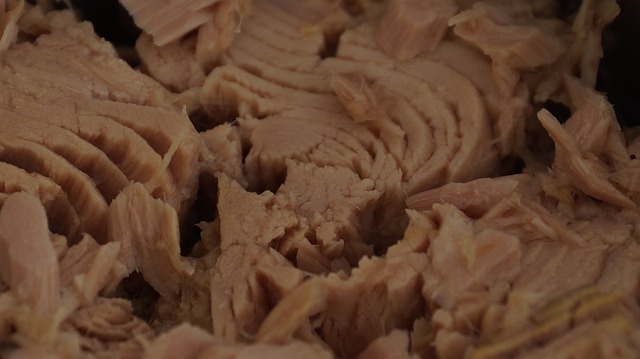 A sandwich is a snack that, on the face of it, is so simple, but when you look deeper into the subject, there's a vast potential for disaster. Basically, a sandwich is bread, butter or some other spread, and filling, and that's where the problems can arise. Each component has to be just right for the perfect sandwich. This is what's in my favourite Spanish sandwich. A sandwich is a snack that, on the face of it, is so simple, but when you look deeper into the subject, there's a vast potential for disaster. Basically, a sandwich is bread, butter or some other spread, and filling, and that's where the problems can arise. Each component has to be just right for the perfect sandwich. This is what's in my favourite Spanish sandwich.
Bread
Obviously, you can't have a sandwich without bread - if there's no bread, there's no sandwich. But what type of bread? For my favourite sandwich, there's only one possible choice. Fresh wholemeal or granary bread, and it has to be ready sliced.
I don't mind uneven slices of bread to go with soup or salad, but if it's a sandwich, I want it nice and level, not looking like a roller coaster made from bread. It's almost impossible to slice a loaf evenly, unless you have a machine to do it, and the bakery's machine is more efficient than anything I can ever come up with.
Spread
I don't do butter these days. Living in Spain, bread is served with just about everything except butter, which is mainly used in cooking. We have olive oil, ali oli or tomato salsa with bread, and I carry this over into my sandwiches. I make my own ali oli with low fat mayonnaise, minced or grated fresh garlic, and a little lemon juice and chopped fresh parsley. The lemon juice adds a tang, and the parlsey tones down the effects of garlic on the breath.
My tomato salsa is simply grated fresh tomato, with a splash of olive oil and freshly ground black pepper. Use a grater with a dish or bowl beneath, and place a whole fresh tomato, pointed end down, on the grater, or cut it in half first. Apply just a little pressure, and the skin will peel back as you grate, forming a protective layer for your fingertips as you work through the tomato. I usually make a big batch of ali oli and salsa, as it keeps well in the fridge for several days.
I'll use one or other of these on my sandwich, but if we're talking my favourite sandwich, it's ali oli on one slice of bread and tomato salsa on the other.
Filling
No contest here - it has to be tuna. The tinned tuna we buy in Spain seems so much chunkier that that available in England. It's usually in olive oil or sunflower oil, but because it's so thick and chunky, you can drain almost every vestige of oil away with no problem, if you're concerned about your fat intake. Once the tuna's in place - always on the bread with ali oli - it's time for the crowning glory. That's a liberal scattering of cold, tinned sweetcorn, topped with thin slices of cucumber. A little extra freshly ground black pepper - I just love it - and then the bread with tomato salsa tops the whole sandwich off.
It takes much less time to make my favourite sandwich than it's taken to write about it. It's a healthy lunch or supper choice, based on the Mediterranean way of eating. My mouth's watering just thinking about it. Time for a sandwich break, I think!
Like what you read? There's lots more at Sandra In Spain.com
 0
Like
Published at 5:46 PM Comments (1)
0
Like
Published at 5:46 PM Comments (1)
Edina's Bar and Grill - new on Lemon Tree Road, Campo de Guardamar, Alicante Province
Wednesday, January 28, 2015
 A while back, one of our favourite eateries when we fancied a Sunday roast was Lo Marabu on Lemon Tree Road. However, they stopped doing the lunches, so we went elsewhere. Driving past last week though, we noticed some activity, so of course, I had to go and investigate. I'm not nosy, you understand - just interested! Anyway, it turns out that Lo Marabu is now under new ownership, and it will re-open for business on 1 February as Edina's Bar and Grill. A while back, one of our favourite eateries when we fancied a Sunday roast was Lo Marabu on Lemon Tree Road. However, they stopped doing the lunches, so we went elsewhere. Driving past last week though, we noticed some activity, so of course, I had to go and investigate. I'm not nosy, you understand - just interested! Anyway, it turns out that Lo Marabu is now under new ownership, and it will re-open for business on 1 February as Edina's Bar and Grill.
Who is Edina? She's one half of the lovely partnership that now own Lo Marabu. And she knows what the locals and visitors want in the way of food and drink, because she's worked there as a waitress for the last 18 months. Before that, she spent 7 years at The Old Don Carlos in Cuidad Quesada, and as she told me, it's not really like hard work, because she loves to see people enjoying themselves with the help of good food and drink and a friendly atmosphere.
Edina is Hungarian, and Ian is a man of impeccable taste. Not only did he choose Edina for his life partner and business partner, he knew I was from the Black Country in the West Midlands. So many people say, 'Are you from Birmingham?' even when I put my posh accent on, but he spotted the subtle nuances that say Black Country, not Brum. He hails from West Bromwich himself, so he's not too far from my old stamping grounds of Wolverhampton and Bilston. This is his first business venture, and from the number of people who dropped in to say hello and ask about the opening while we were there, it's going to be a roaring success.
Ian and Edina have spent 9 years in Spain, and they're looking forward to running their new business together. They only got the keys on 19 January, but already they've redecorated the bar and given it a fresh new look. They'll be offering breakfasts, special meal deals, and the Sunday lunches will be back with a vengeance. So, whether you want a coffee, a cheeky snifter or a 3 course meal with all the trimmings, stop by at Edina's Bar and Grill sometime soon. Tell them Sandra sent you - although I'll probably be there ahead of you. I just love what they have planned, and so will you.
For reservations - recommended, especially for Sunday lunch - call 672 787 769
Like this post? There's much more at Sandra in Spain
 0
Like
Published at 2:05 AM Comments (2)
0
Like
Published at 2:05 AM Comments (2)
Restaurant review: Spice City, La Finca, Algorfa - Alicante province
Wednesday, December 3, 2014
 Don’t you just love it when a great restaurant opens within easy walking – or staggering – distance of home? In a perfect world it would be a Spanish restaurant, but a close second is Indian. Back in April, Spice City opened in the old Witchery building on the La Finca Commercial Centre in Algorfa, and we were one of the first people to try it out. Our favourite Indian restaurant in the area is Punjabi Palace in Los Montesinos, so the lovely staff at Spice City had a job on their hands if they were going to convince us to convert. Don’t you just love it when a great restaurant opens within easy walking – or staggering – distance of home? In a perfect world it would be a Spanish restaurant, but a close second is Indian. Back in April, Spice City opened in the old Witchery building on the La Finca Commercial Centre in Algorfa, and we were one of the first people to try it out. Our favourite Indian restaurant in the area is Punjabi Palace in Los Montesinos, so the lovely staff at Spice City had a job on their hands if they were going to convince us to convert.
The first time we ate there, we opted for the €8.95 Lunchtime Special. That’s puppadoms and pickles, followed by any main course chicken or lamb dish with rice or naan, a dessert or coffee and a drink. The food was excellent, but we did have one minor issue – you couldn’t call it a complaint. At Punjabi Palace, all the main courses come out over a tea light burner, which keeps the food really hot if you want to linger over lunch or dinner. If you’re a real lingerer, it’s best to go for a Tandoori dish, which comes out on a sizzler plate.
That’s by the bye, because this review concerns what I honestly believe is the best meal deal in these parts, aside from Restaurante Alquibla. The Special Evening Meal for Two comes in at €30 per couple, and for that you get two starters, two main courses with rice, naan or one of each, a vegetable dish to share, and a bottle of wine. However, if you want to try one of Spice City’s fabulous prawn dishes, opt for a la carte, because they are not included in the meal deal. Pretty much everything else is, though, so there’s plenty of choice.
The first time we opted for this deal, we asked for puppadoms too – after all, you can’t have an Indian without puppadoms, can you? It would be like Bonnie without Clyde, or me without cava and vodka – utterly unthinkable! It turns out the puppadoms are in on the deal anyway, and when we took our great granddaughter Madison with us, they even gave us an extra puppadom for her. Most of it ended up on the floor, but hey, they needn’t have done that. At 7 months, she had a great introduction to Indian food, and the staff made a real fuss of her, even though our table and the surrounding area looked like the epicentre one of the famous Algorfa Earthquakes!
Our last visit to Spice City was just before I flew to England, and we took along our friends Paul and Venessa to  introduce them to its delights. What I like about Spice City is that you get a warm welcome, whether it’s your first visit or, like us, you’re a regular diner. The staff make you feel at home the moment you walk through the door. introduce them to its delights. What I like about Spice City is that you get a warm welcome, whether it’s your first visit or, like us, you’re a regular diner. The staff make you feel at home the moment you walk through the door.
It took a while to decide what we were having, but in the end we plumped for lamb tikka and chicken tikka, plus onion bhajis and vegetable pakora for starters. As you can see, they don’t do small servings at Spice City, and by the time we’d fought our way through the puppadoms and the starters, we were seriously worried about where the main courses would fit in. In fact it looked very much like we’d be taking most of it home for the next day, and that’s pretty much what happened. One word of advice – never go to Spice City in a fitted dress or slightly tight trousers, because you will regret it!
We asked for a ceasefire in the food fest while we digested the starters and made inroads into the wine. When we finally got to the main event, Tony’s face told me he bitterly regretted ordering the Special Tandoori Mixed Grill, because there was no way he was going to work his way through all that. I felt the same about my Special Biryani, although Paul and Venessa did pretty well with their Chicken Balti and Chicken Dhansak. Still, it saved me having to cook the next night!
 The Bombay Potatoes and Aloo Gobi, along with pilau rice and naan, were the perfect accompaniments. Everything was nice and hot, and perfectly cooked. I don’t know what magic they work on the lamb, but it was so tender you didn’t need a knife, you could cut it with the fork. Another thing that is a bit of a hobby horse of mine is the plates. Restaurants always get extra Brownie Points if they serve up my meal on a hot plate, and Spice City do just that. The Bombay Potatoes and Aloo Gobi, along with pilau rice and naan, were the perfect accompaniments. Everything was nice and hot, and perfectly cooked. I don’t know what magic they work on the lamb, but it was so tender you didn’t need a knife, you could cut it with the fork. Another thing that is a bit of a hobby horse of mine is the plates. Restaurants always get extra Brownie Points if they serve up my meal on a hot plate, and Spice City do just that.
For me, Spice City ticks all the boxes. It’s close to home, the food is great, the staff are friendly and the prices are right. If you haven’t checked out this great Indian restaurant already, why not try it soon? And tell them Sandra sent you – or better still, give us a shout and we’ll tag along with you!
If you enjoyed reading this, check out my blog Sandra In Spain
 0
Like
Published at 10:24 AM Comments (1)
0
Like
Published at 10:24 AM Comments (1)
Could this be the best rosado in Spain?
Thursday, October 30, 2014
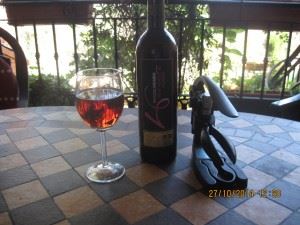 When we went to Lemon Tree Road Market on Sunday, we noticed that one of the stalls was selling wines. That’s always of interest to the residents of Piddock Place, but what was particularly interesting was that one of the wines was marked up as ‘The best rosado in Spain,’ and it was priced at just 5€. Now, I love rose wine almost as much as I love cava, so I had to have some of that. Tony was a bit off about paying 5€ for a bottle of rose – mainly because he doesn’t like it. However, I told him I had to have it, because it would make a really interesting post for the blog. That’s my excuse and I’m sticking to it! When we went to Lemon Tree Road Market on Sunday, we noticed that one of the stalls was selling wines. That’s always of interest to the residents of Piddock Place, but what was particularly interesting was that one of the wines was marked up as ‘The best rosado in Spain,’ and it was priced at just 5€. Now, I love rose wine almost as much as I love cava, so I had to have some of that. Tony was a bit off about paying 5€ for a bottle of rose – mainly because he doesn’t like it. However, I told him I had to have it, because it would make a really interesting post for the blog. That’s my excuse and I’m sticking to it!
My friend Angela is over from the UK for a few days to sort out a minor crisis, and she’s been enjoying a few glasses of wine with me at night to unwind. Up to now, we’ve unwound to the tune of about 6 or 7 bottles over three evenings, so when she came around for supper last night, I suggested we open ‘The best rosado in Spain’ before we became too unwound to know or care what we were drinking.
So then, what were we drinking? Pago del Vicario’s Petit Verdot Rosado, from Castile- La Mancha. As an interesting by-the-way, the estate at Casas near Cuidad Real has a hotel, so if you want a serious tasting session, you can book into the hotel and sleep it off.
Our bottle was the 2013 vintage, and the first thing we noticed was the 15% alcohol by volume. So we thought we were in for more of a fortified wine than a light crisp rose. And we were right, although it’s nothing like a port or sherry. The colour is amazing – dark pink, almost red, with a satin sheen to it that made it look really good in the glass.
When it came to the nose, the main thing that hit us was the aroma of red berries – strawberries and raspberries in particular, combined with a slightly creamy smell. All in all, it seemed more like liquid food than drink, and that might put some people off, especially those used to a lighter Spanish rose. However, a wine has to be really bad to deter us, so it was bottoms up time.
The fruity flavours of the nose came through on the taste buds – it was almost like drinking a fruit punch, but with that kick that you get from a high alcohol content. It was slightly sweet, but not overly sweet, so you couldn’t really categorise it as a dessert wine. The robust flavour went well with the chilli con carne I served up for supper, but it would be rather overpowering as an accompaniment for fish and poultry. It’s definitely a red meat wine.
Did we enjoy it? Most definitely. Would I buy it again? Double definitely. Is it really ‘The best rosado in Spain?’ No, because it isn’t really a rosado you can compare with others on a like for like basis. However, if you like a bit of oomph in your wine, this is one for the rack. It’s a wine to savour in small doses, rather than a good old session with friends. Vino collapso it isn’t – it’s too rich and full bodied to knock back in industrial quantities. Apart from that, the colour hints at a heavy dose of congeners, so you might wake up with the Hangover from Hell if you’re too enthusiastic with this one. Just saying!
I have a brand new, shiny website - Sandra In Spain! Take a look here, and tell me what you think.
 0
Like
Published at 10:04 AM Comments (0)
0
Like
Published at 10:04 AM Comments (0)
Estofado de Garbanzos y Patatas - excellent autumn food
Wednesday, October 1, 2014
 I love Spanish food, especially the 'peasant style' stews and soups, which are ideal for winter, yet also light enough to be enjoyed all year round. One of my favourite recipes is estofado de garbanzos y patatas, or chickpea and potato stew. It's also one of the most versatile recipes there is. Here's my favourite version of the recipe, which I managed to coax out of the cook in our favourite Spanish family-run restaurant: I love Spanish food, especially the 'peasant style' stews and soups, which are ideal for winter, yet also light enough to be enjoyed all year round. One of my favourite recipes is estofado de garbanzos y patatas, or chickpea and potato stew. It's also one of the most versatile recipes there is. Here's my favourite version of the recipe, which I managed to coax out of the cook in our favourite Spanish family-run restaurant:
Ingredients for 4 servings
- · 4 medium – large and 1 small potato
- · 1 large ripe tomato
- · 1 large onion, chopped
- · 1 – 2 cloves garlic
- · 1 540g jar of cooked chickpeas (garbanzos), drained and rinsed
- · Olive oil
- · Knob of butter
- · Sea salt and freshly ground black pepper
- · 1 tbsp fresh or freeze dried parsley
- · 2 level tsps paprika
- 1 tablespoon tomato frito (puree)
- · Small glass of red wine (optional)
·Heat a little olive oil and soften the onions and garlic. Now add a small knob of butter and the wine, if using. Add parsley, salt and pepper.
Grate the tomato into the mixture, then add paprika and a little water to prevent burning. Cook for a couple of minutes.
Now add chickpeas and large sliced potatoes, tomato puree, optional vegetables and enough water to cover everything. Simmer for about 45 minutes, then grate the small potato into the stew to help thicken the gravy. Cook for another half hour, until everything is cooked through and the gravy is nice and thick.
Serve with fresh crusty bread. This stew is even better cooked the day before you need it, as this gives the flavours plenty of time to develop.
Grated tomatoes?
Yes! It's a trick used by jut about anyone who cooks in Spain. Gives a great consistency to the food, and it's very versatile too. just cut a ripe tomato in half, and use a grater with an integrated bowl to catch the fallout. Don't worry about grating your fingers - the tomato skin will peel back and form a protective shield. For an awesome tomato paste to spread on your bread, just add a little pepper, olive oil and tomato frito to a couple of large grated tomatoes. It will keep in the fridge for several days if covered.
Preparing the potatoes
This is a trick I also learned from the cook. Peel and slice the potatoes into fairly thick slices - maybe half an inch across. Now break each slice into 2 - 4 chunks, depending on the size. This creates uneven surfaces which release extra starch into the stew and help to thicken it. It's a good technique to use in any soups and stews, as it thickens without the need for flour or other agents.
Add meat if you like
If you want meat in your estofado, you can add smoked bacon lardons (taquitos) with the onions and garlic. Or add slices of chorizo or morcilla (black sausage). You can even mix it up with different types of sausage, and you don't need to increase the cooking time.
Vegetables
The stand-alone recipe is fine, but I think it's even better with extra vegetables. Peppers, courgettes, spinach aubergines, celery and green beans go particularly well with this, but you can add anything you fancy.
I tend to make a big pan of this and freeze it for later use. It's very economical too - around 5 - 7 Euro to make a huge pan that will easily feed 8 hungry people. Buen Provecho!
 2
Like
Published at 9:59 AM Comments (0)
2
Like
Published at 9:59 AM Comments (0)
Restaurant Review: Restaurante Alquibla, Algorfa, Alicante Province
Friday, September 26, 2014
 As you stroll Along Avenida Maria Del Mar Rodriguez - Algorfa's sleepy main street - you'll almost certainly be drawn to the large blackboard outside Restaurante Alquibla which details the Menu del Dia. For just 9 Euro at lunchrime and 11 Euro in the evenings (12 and 15 Euro respectively on Saturdays and Sundays) you can enjoy 4 courses with bread, ali oli, tomato paste and half a bottle of wine per person. As you stroll Along Avenida Maria Del Mar Rodriguez - Algorfa's sleepy main street - you'll almost certainly be drawn to the large blackboard outside Restaurante Alquibla which details the Menu del Dia. For just 9 Euro at lunchrime and 11 Euro in the evenings (12 and 15 Euro respectively on Saturdays and Sundays) you can enjoy 4 courses with bread, ali oli, tomato paste and half a bottle of wine per person.
Alquibla has been run by the same family for as long as anyone in the village can remember. Madre does the cooking, while her son and husband do the serving. In between courses Papa can be found at the table in the bar, playing cards for cash with his compadres, but as soon as the call from the kitchen comes, he's on his feet.
Last week, the husband added to his store of Brownie Points by sweeping me off to Alquibla for Sunday lunch. He reckoned I was spending too much time writing and I deserved a break. I wasn't about to disagree - especially as Alquibla is my favourite restaurant bar none.
As we waited for our first course,the waiter brought a bottle of the house white over. I have to say 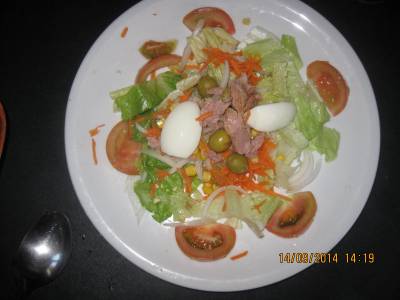 it's one of the best house wines we've ever had. In fact often we splash out an extra 6 Euro on a second bottle. Then it's time for the bread and ali oli, and the house special salad. It seems that every time we go to Alquibla there is even more salad on the plate - it's almost a meal on it's own, and so fresh I think they must keep it on ice. it's one of the best house wines we've ever had. In fact often we splash out an extra 6 Euro on a second bottle. Then it's time for the bread and ali oli, and the house special salad. It seems that every time we go to Alquibla there is even more salad on the plate - it's almost a meal on it's own, and so fresh I think they must keep it on ice.
 Alquibla offer a choice of around 5 starters, but a soon as I saw paella on the menu that was me sorted. It was rabbit paella, and as usual it was cooked to perfection. Tony chose the meatball soup, and I would have included a pic so you could see the size of the meatball, but he was in there before I could say 'smile.' I kid you not, there must have been at least 100 grams of meat in it - it was almost the size of a tennis ball. Alquibla offer a choice of around 5 starters, but a soon as I saw paella on the menu that was me sorted. It was rabbit paella, and as usual it was cooked to perfection. Tony chose the meatball soup, and I would have included a pic so you could see the size of the meatball, but he was in there before I could say 'smile.' I kid you not, there must have been at least 100 grams of meat in it - it was almost the size of a tennis ball.
After demolishing that lot, I wondered if I'd have room for my grilled tuna, but it was so perfectly 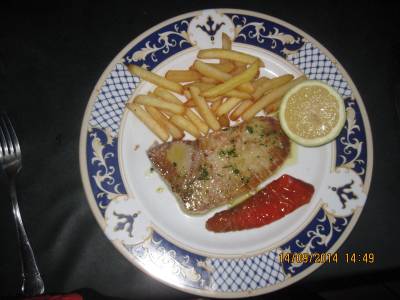 cooked, and so moist it just slipped down easily. Tony went for the rump steak, which was so tender the steak knife was surplus to requirements. I left at least half of my chips, but it would have been rude to have left even a morsel of that succulent tuna. cooked, and so moist it just slipped down easily. Tony went for the rump steak, which was so tender the steak knife was surplus to requirements. I left at least half of my chips, but it would have been rude to have left even a morsel of that succulent tuna.
We still had Alquibla's famous desserts to go, and I was glad I'd chosen to wear a dress with an elasticated waist, because I could almost feel myself expanding. I'm obviously predictable in my habits, because the waiter asked if I would like tarta queso (cheesecake) before running through the available options for Tony. He chose apple cake, and we surprised ourselves by demolishing the lot.
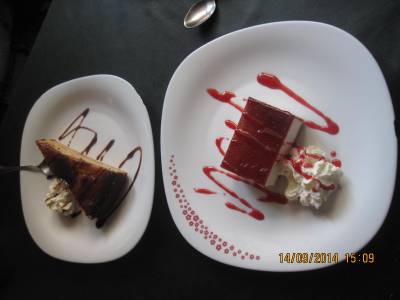 Over the 6 years we've lived in Algorfa, we've been to Alquibla dozens of times, and we've never been disappointed. If I have one small criticism, it's that during the week, there are only two choices of main course, a meat course and a fish course. That said, there is always something I like, and the choices are written up outside, so you can decide before you go in. And of course, it helps to keep the price down. at weekends there are more main course options to choose from, and there is a children's menu available at 6 Euro a head. As well as the usual suspects like fish fingers and burgers, there's home made pizza, and smaller servings of some of the main course options. In fact, the kids meal would be more than enough for an adult with a small appetite. Over the 6 years we've lived in Algorfa, we've been to Alquibla dozens of times, and we've never been disappointed. If I have one small criticism, it's that during the week, there are only two choices of main course, a meat course and a fish course. That said, there is always something I like, and the choices are written up outside, so you can decide before you go in. And of course, it helps to keep the price down. at weekends there are more main course options to choose from, and there is a children's menu available at 6 Euro a head. As well as the usual suspects like fish fingers and burgers, there's home made pizza, and smaller servings of some of the main course options. In fact, the kids meal would be more than enough for an adult with a small appetite.
Restaurante Alquibla is on Avenida Maria Del Mar Rodriguez, midway through the village on the right hand side opposite Mailpoint as you head in the direction of Benijuzar. It's closed on Mondays, but open for lunch and dinner from Tuesday to Sunday. Booking is advisable, especially at weekends and evenings in the summer.
Phone: 965 701 972
 0
Like
Published at 9:16 AM Comments (0)
0
Like
Published at 9:16 AM Comments (0)
Cool food for hot August days
Thursday, August 28, 2014

Okay, we really shouldn't complain - not when it's lashing down in England, and people are posting all over Facebook that it's so cold they've had to light the wood burners and dust off the thermal underwear. But it just seems to be getting hotter and hotter. Here in Piddock Place, the most we can face most days is a sandwich. Much as we love salads and barbecues, we're a bit sick of them now. It's just been too darn hot to cook.
But when friends came for supper on Saturday, we could hardly serve up cheese and tomato sarnies, now could we? And I was guessing that they were probably about as sick of salads as we are. So I got my thinking cap on and came up with a supper idea that actually went down a storm.
For staters, I decided to do a twist on stuffed peppers. There are some lovely miniature peppers around at the moment - sweet and tender, so they don't need to be cooked. In fact, you don't even need to remove the ribs and seeds, I just halved them, and removed the stalk - although you could leave that intact for presentation purposes. Never thought about it until I was half way through though!
I kept the fillings simple, because when it's hot, simple is best. And I went for fishy fillings rather than meat and rice.
Tuna, egg and capers
Quantities don't really matter here - it depends how many you're catering for really.
- Tuna
- Finely chopped hard boiled egg
- A few chopped capers
- Mayonnaise, lemon juice, black pepper
Just mix everything together, and pile into the peppers. You're aiming for a slightly stiff consistency here, so it doesn't spill out, so add the lemon juice and mayo little by little, tasting as you go.
Crab salad and cucumber
You can make your own crab salad with chopped crab sticks, a little smoked paprika and some freshly ground black pepper, lemon juice and mayonnaise. On the other hand, if you're feeling too hot to be bothered even to do that, you can use a ready made one. Then just mix in some finely chopped cucumber, for texture and flavour. I was going to add sweetcorn too, but I didn't find it in time!
I just halved some olives and plum cherry tomatoes, for decoration and an extra taste and texture sensation. Just before serving, I sprinkled with a little smoked paprika. That too added a little extra in the flavour stakes.
There are all sorts of combinations that would work well here - grated cheese, chopped tomato and onion, or taquitos de jamon and scrambled eggs come to mind. Really, anything you have in the fridge or the cupboards can be pressed into service here.
The sweet taste of the peppers, combined with the savoury fillings and the smoky paprika is fresh on the tongue - just what you want on a hot day, and they re surprisingly filling.
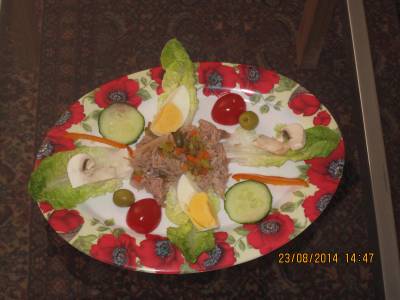
The main course was a bit of a twist on a Salade Nicoise. Tuna, eggs, olives, tomato, cucumber, lettuce peppers and mushrooms. I didn't dress the salad, just drizzled with lemon juice and sprinkled with black pepper. I used one of those large tins of tuna you can get in the supermarket,s because they're nice and chunky. It's easy to drain off the oil, and it looks good on the plate too. I always buy mine from Lidl. At 5.19 Euro, not only is it the cheapest around, its also very tasty.
I served up the salad with bread, ali oli and tomato paste, and again, it ws a perfect meal for a hot evening - nice combination of flavours, and enough without being heavy on the stomach. And thanks to the protein content in the egg and tuna, we didn't feel hungry again in a couple of hours.
So, there you have it - a simple supper or lunch, hardly any preparation or cooking time and a nice combination of Mediterranean colours and flavours. What's not to love?
 1
Like
Published at 2:35 AM Comments (2)
1
Like
Published at 2:35 AM Comments (2)
Spam post or Abuse? Please let us know
|
|